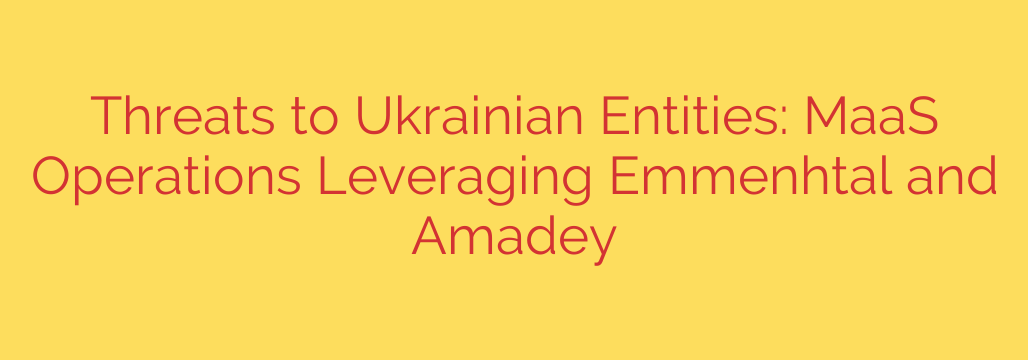
Ukraine Under Cyber Siege: Unpacking the New Wave of Phishing Attacks
Ukrainian organizations, particularly government agencies and state-owned enterprises, are currently facing a highly coordinated and dangerous cyber offensive. A sophisticated threat actor, tracked as UAC-0099, is leveraging advanced malware in a multi-stage attack designed to infiltrate networks, steal sensitive information, and establish long-term persistence.
These attacks are not random; they are surgically precise, using carefully crafted phishing emails as the primary entry point. Understanding the mechanics of this campaign is the first step toward building a resilient defense.
The Attack Vector: Deceptive Phishing Campaigns
The initial infiltration relies on a classic but effective technique: socially engineered phishing emails. Attackers are impersonating legitimate Ukrainian state bodies, most notably the State Emergency Service of Ukraine (DSNS).
These emails are designed to look official and urgent, often containing subject lines related to critical alerts or official procedures. The goal is to trick an unsuspecting employee into opening a malicious attachment, typically a ZIP archive containing a harmful file. Once the user interacts with the file, the infection chain begins, unleashing a powerful duo of malware onto the victim’s system.
A Two-Stage Malware Assault: Emmenhtal and Amadey
The attack unfolds in two distinct stages, using a loader to establish a foothold before deploying a more powerful payload.
Stage One: Emmenhtal (SmokeLoader) Opens the Door
The first piece of malware to execute is Emmenhtal, a well-known modular backdoor also identified as SmokeLoader. Think of Emmenhtal as a digital lockpick and reconnaissance tool. Its primary functions include:
- Establishing Initial Access: It creates a backdoor into the compromised system.
- System Profiling: It gathers information about the infected machine, such as its operating system, security software, and user privileges.
- Persistence: It embeds itself deep within the system to ensure it can survive a reboot.
Once Emmenhtal has successfully established its presence and confirmed the target is valuable, it signals its command-and-control (C2) server to deliver the second-stage payload.
Stage Two: Amadey Botnet Deploys for Impact
With the door wide open, the attackers deploy Amadey, a versatile and dangerous botnet malware. Amadey has been active for years and is known for its wide range of malicious capabilities. Once installed, it can:
- Steal Sensitive Information: Harvest system data, user credentials, and other valuable information.
- Execute Remote Commands: Allow attackers to run commands directly on the infected machine.
- Load Additional Malware: Act as a dropper for other malicious tools, such as ransomware, spyware, or banking trojans.
- Perform Reconnaissance: Map out the internal network for further lateral movement.
The combination of Emmenhtal and Amadey creates a potent one-two punch, allowing attackers to quickly escalate a simple email compromise into a full-blown network intrusion.
The Rise of Malware-as-a-Service (MaaS)
A significant aspect of this campaign is its reliance on Malware-as-a-Service (MaaS). Both Emmenhtal and Amadey are commercially available malware tools sold on underground forums. This model lowers the barrier to entry for threat actors, allowing groups like UAC-0099 to launch sophisticated attacks without developing their own custom tools from scratch.
While UAC-0099 is often described as financially motivated, its specific targeting of strategic Ukrainian government and state-run entities suggests a potential overlap with state-sponsored objectives. The use of MaaS can also serve to muddy the waters of attribution, making it harder to definitively link the attacks to a specific nation-state.
How to Defend Your Organization: Actionable Security Measures
Defending against such targeted attacks requires a multi-layered security strategy. Organizations must move beyond basic protections and implement a more robust, proactive defense.
- Intensify Employee Training: Your staff is the first line of defense. Conduct regular, mandatory security awareness training focused on identifying and reporting phishing attempts. Simulate phishing attacks to test and reinforce this training. Emphasize that employees should never open attachments or click links from unsolicited or suspicious emails, even if they appear to come from a trusted source.
- Strengthen Email Security: Implement advanced email filtering solutions that can scan for malicious attachments, links, and signs of sender impersonation. Configure DMARC, DKIM, and SPF records to prevent domain spoofing and enhance email authentication.
- Deploy Advanced Endpoint Protection: Traditional antivirus is no longer enough. Use an Endpoint Detection and Response (EDR) solution that can monitor system behavior for signs of malware like Emmenhtal and Amadey, even if their signatures are unknown.
- Monitor Network Traffic: Actively monitor outbound network connections for suspicious activity. Malware needs to communicate with its C2 server. Look for unusual traffic patterns, connections to known malicious IP addresses, or data exfiltration.
- Implement the Principle of Least Privilege: Ensure users only have access to the data and systems they absolutely need to perform their jobs. This can limit an attacker’s ability to move laterally across the network if an initial account is compromised.
- Maintain a Robust Incident Response Plan: Have a clear, actionable plan for what to do when a breach is detected. This plan should include steps for isolation, investigation, eradication, and recovery to minimize damage and downtime.
The ongoing cyberattacks against Ukraine are a stark reminder that vigilance is paramount. By understanding the tactics of threat actors like UAC-0099 and implementing layered, proactive security controls, organizations can significantly improve their posture and defend against these persistent threats.
Source: https://blog.talosintelligence.com/maas-operation-using-emmenhtal-and-amadey-linked-to-threats-against-ukrainian-entities/








